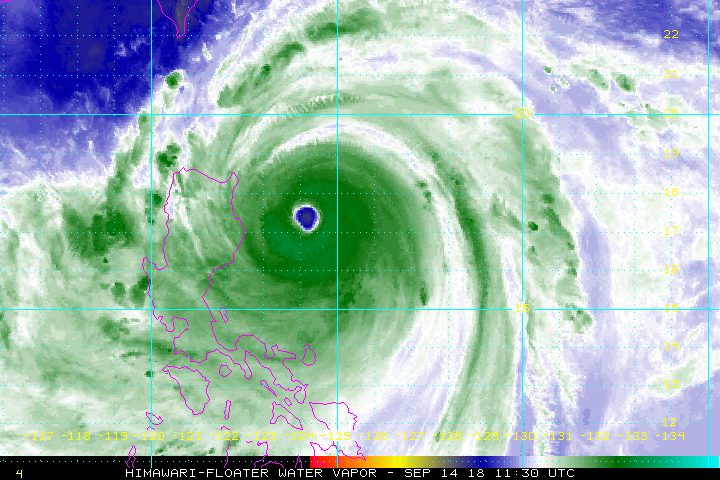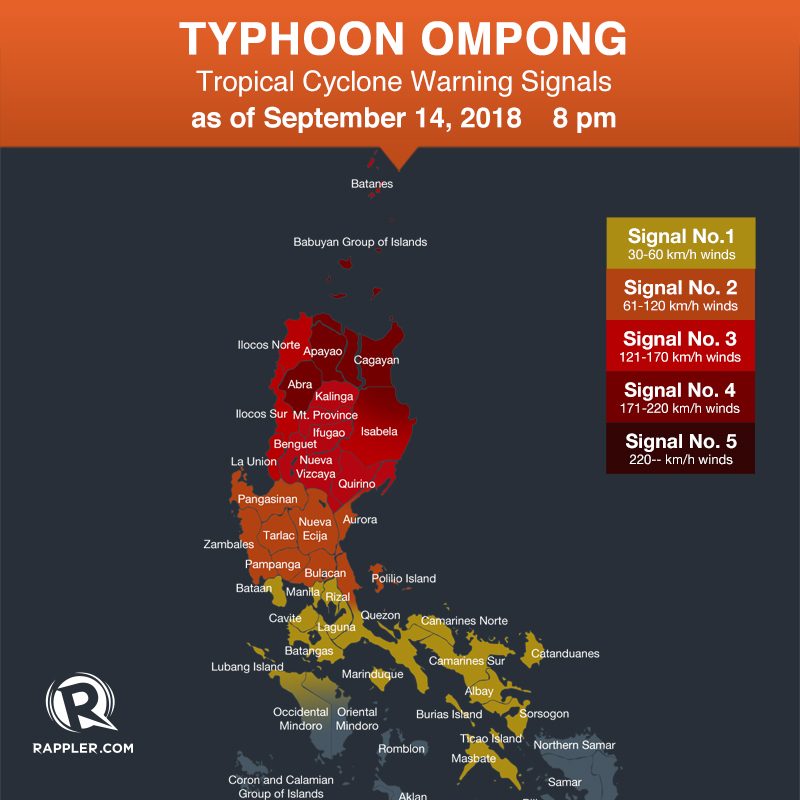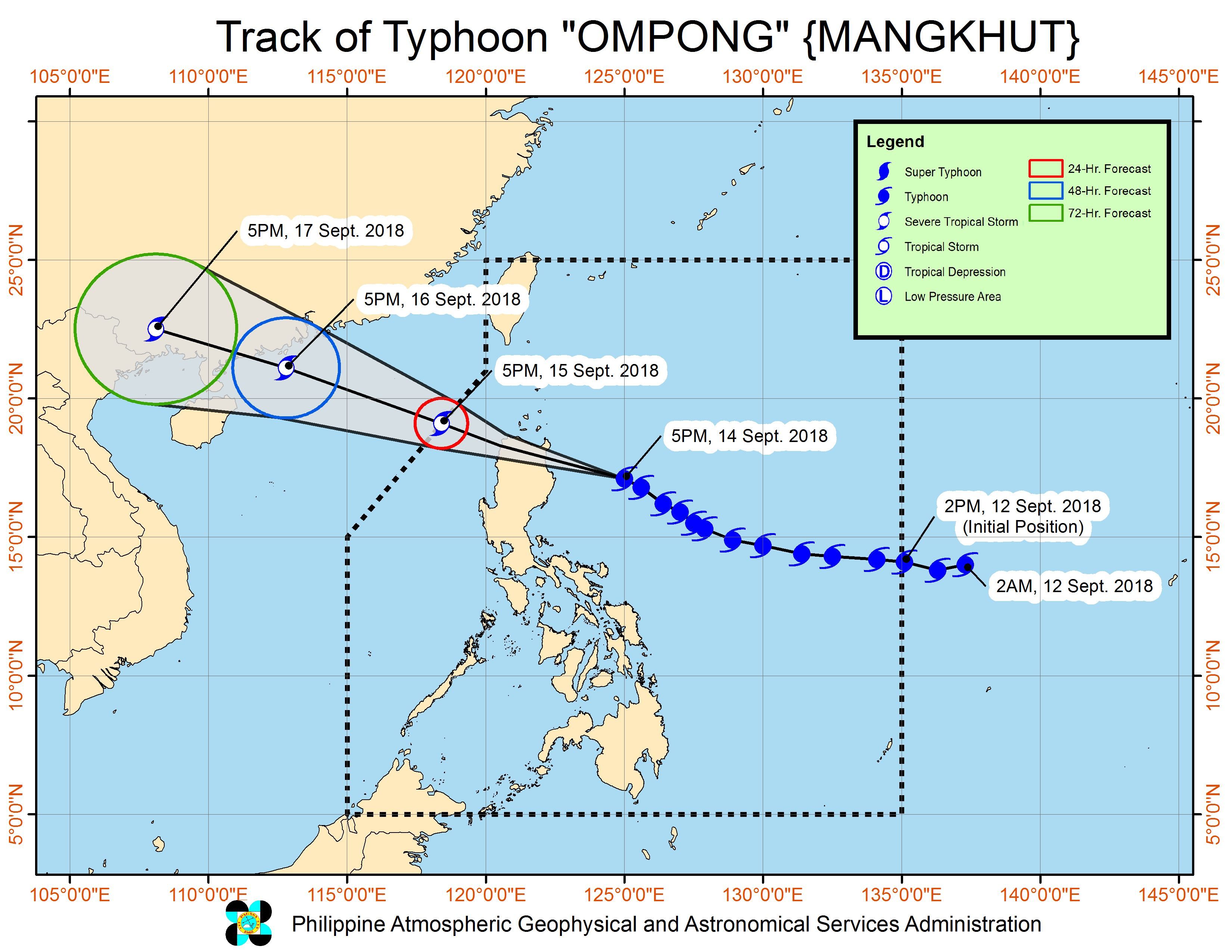SUMMARY
This is AI generated summarization, which may have errors. For context, always refer to the full article.

What’s the weather like in your area? Report the situation through Rappler’s Agos or tweet us at @rapplerdotcom.
MANILA, Philippines – Typhoon Ompong (Mangkhut) is on track to make landfall in the Cagayan-Isabela area in the wee hours of Saturday, September 15, as it maintained its speed and strength early Friday evening, September 14.
In a bulletin released past 8 pm on Friday, the Philippine Atmospheric, Geophysical, and Astronomical Services Administration (PAGASA) said Ompong is already 260 kilometers east northeast of Casiguran, Aurora, still moving northwest at 30 kilometers per hour (km/h).
The typhoon continues to have maximum winds of 205 km/h and gustiness of up to 255 km/h. Even if PAGASA does not yet classify Ompong as a super typhoon, it remains to be a powerful tropical cyclone with a huge diameter of 900 kilometers.
Ompong’s landfall in the Cagayan-Isabela area could be between 1 am and 3 am on Saturday. Thousands of people earlier evacuated in the two provinces, and thousands more in other areas as well. (READ: Will Typhoon Ompong be the same as Super Typhoon Lawin?)
Below are the tropical cyclone warning signals in place.
Signal No. 4:
- Cagayan
- northern part of Isabela
- Apayao
- Abra
Signal No. 3:
- Batanes
- Babuyan Group of Islands
- southern part of Isabela
- Ilocos Norte
- Ilocos Sur
- La Union
- Kalinga
- Mountain Province
- Benguet
- Ifugao
- Nueva Vizcaya
- Quirino
- northern part of Aurora
Signal No. 2:
- Pangasinan
- Tarlac
- Nueva Ecija
- southern part of Aurora
- Zambales
- Pampanga
- Bulacan
- northern part of Quezon including Polillo Island
Signal No. 1:
- Bataan
- Rizal
- Metro Manila
- Cavite
- Batangas
- Laguna
- southern part of Quezon
- northern part of Occidental Mindoro including Lubang Island
- northern part of Oriental Mindoro
- Masbate
- Marinduque
- Camarines Norte
- Camarines Sur
- Catanduanes
- Albay
- Sorsogon
- Burias and Ticao islands

Stormy weather is expected in areas under Signal Nos. 2, 3, and 4, while there will be occasional rains and gusty winds in areas under Signal No. 1. The National Disaster Risk Reduction and Management Council estimated that at least 5.2 million people are in the path of the typhoon.
PAGASA warned that serious floods and landslides are possible, while many trees could get uprooted and homes made of light materials may be damaged.
Coastal areas in Cagayan and Ilocos Norte could also experience storm surges up to 6 meters high, while Isabela and Ilocos Sur could have storm surges up to 2 meters high. (READ: FAST FACTS: Tropical cyclones, rainfall advisories)
Fishermen and others with small sea vessels are advised not to venture out into the seaboards of areas under tropical cyclone warning signals, and in the seaboards of the Visayas and Mindanao.
More than 4,800 passengers have been stranded in various ports. Dozens of domestic and international flights have been canceled.
Class suspensions were also announced for the rest of the week. (READ: #WalangPasok: Class suspensions for September 13, 14, 15)
Based on its latest forecast track, Ompong might leave the Philippine Area of Responsibility (PAR) on Saturday afternoon. This estimated time of exit could still change if it slows down.

The typhoon is also enhancing the southwest monsoon or hanging habagat. The enhanced southwest monsoon could trigger moderate to heavy rain in the Visayas, and light to heavy rain in Palawan, the Zamboanga Peninsula, Northern Mindanao, and Caraga.
Residents of areas affected by the southwest monsoon should be on alert for flash floods and landslides, too.
National government agencies, local government units, the Armed Forces of the Philippines, the Philippine National Police, and the Philippine Coast Guard were placed on alert to respond to the typhoon. (READ: What gov’t has done so far to prepare for Typhoon Ompong)
Ompong is the Philippines’ 15th tropical cyclone for 2018. The country usually gets an average of 20 tropical cyclones per year. (READ: LIST: PAGASA’s names for tropical cyclones in 2018)
PAGASA declared the start of the rainy season last June 8. – Rappler.com
News you can use during Typhoon Ompong (Mangkhut):
- Weather updates and storm signals
- Reports on evacuation, emergencies, and rescue and relief efforts
- Typhoon Ompong: Free parking at SM, Ayala, Robinsons, Megaworld malls
- #WalangPasok: Class suspensions for September 13, 14, 15
- Canceled flights due to Typhoon Ompong
- Will Typhoon Ompong be the same as Super Typhoon Lawin?
- What gov’t has done so far to prepare for Typhoon Ompong
- Fact-check on viral stories related to Typhoon Ompong
Add a comment
How does this make you feel?
There are no comments yet. Add your comment to start the conversation.